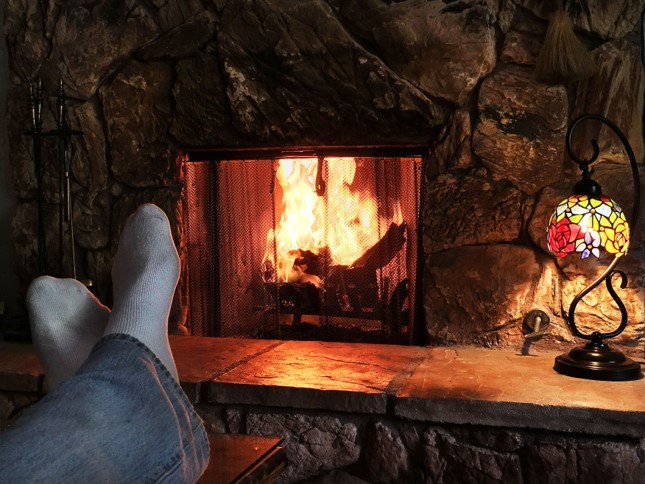
888LogGuys
- Log Home Decor
While you may see fireplaces added more often to all home construction, in a log home they hold a more prominent position. After all, a cabin without a fireplace is like a bed without a pillow. Of course, just as there are varying log home styles for different buyers, there are also all manner of fireplaces and woodstoves. We’ve listed a few style options and their pros and cons below. With any of these there is of course regular maintenance and attention that needs to be adhered to for your safety and the longevity of the fireplace.
Wood
Wood fireplaces add a rustic look and feel to your living room.
Pros
- Electricity isn’t an issue. With a wood fireplace, you can cook and heat your house without a problem.
- A variety of wood, and if you have land, you can keep cost down and do it yourself. Some give off nice aromas, where others can burn for different lengths of time.
- There’s a general aesthetic. Using real wood gives your home an authentic atmosphere with both the smell and sound that will fill your home.
Cons
- It is generally more to maintain. You have to constantly tend to the fire, even when the fire is out, and the ashes are warm. It can also become unsafe when your fireplace is not consistently maintained and inspected.
- Log storage. You will need to have somewhere dry and safe to store them all. Plus, the cost of the wood, if you chose to not do it yourself.
- Overall efficiency. Even though a natural fireplace may decrease costs in some areas, it may also let drafts enter or escape. Overall, they are not efficient at heating as a standalone wood or pellet burning stove.
Gas
These fireplaces are useful for busy people who still want a natural appearance with their fireplace.
Pros
- You get instant fire! You don’t have to split wood or hassle with matches to get warm.
- There’s not much maintenance. There is no ash cleanup; though you will need to inspect it every once in a while, inspection is not as much of a priority as it is with real wood-burning hearth.
- They can be more energy efficient. You can cut long-term costs by turning on the fire and using special appliances to spread the heat around your home.
Cons
- Installation and operation, if used frequently can be expensive!
- They aren’t quite the real thing. They do not have the same look and feel of a wood burning unit.
Electric
Electric fireplaces provide both heat and light and often use an animated fire once plugged in.
Pros
- Your just need to plug them in. They can be portable and have an easy installment.
- They are good for small spaces. If you have a smaller home or a small room or hallway that needs heated, an electric fireplace can be a huge benefit!
Cons
- The fire isn’t real. If you want a fireplace for the ambiance, electric hearths use animations of fires rather than real ones. Some come with sound effects, but they are still clearly fake.
- There are limited styles. If you are wanting a fireplace with a unique look, you won’t find it with an electric option.
- They don’t work when your electricity is out. If you need heat but the electricity is out, there won’t be much you can do. They can also add significantly to your electric bill.
Pellet Stove
A pellet stove burns pellets made from organic materials such as food or wood waste, they are very eco-friendly.
Pros
- They’re easy to use, ignites at the push of a button. No kindling or tending to the fire required.
- Cleaning is a breeze. There is no creosote buildup and less ash volume compared to wood.
- Pellet bags are easier to transport, handle and stack.
- Pellets take up less storage space than firewood.
- You have greater temperature control. Turn a thermostat dial to get the perfect temperature.
- They’re eco-friendly because there’s very little air pollution. Pellets burn cleaner than wood.
Cons
- It’s expensive to maintain compared to firewood and needs more upkeep than a fireplace. Initial purchase and installation is expensive.
- The fan makes low, mechanical noise.
- Aren’t as visually appealing as watching a fire in a fireplace.
- It needs a backup system like batteries or electricity to run in case of a power outage.
As mentioned, all fireplaces need maintenance and upkeep as well as a fire safety protocol. Here are a few tools and maintenance suggestions for fireplace safety:
Fire Extinguisher
Fires can happen anywhere, and the risk increases when you have a fireplace. Fortunately, fire extinguishers are easy to use once you’ve been properly trained. You can purchase a fire extinguisher at your local hardware store.
Easy Access to a water source:
With grease fires being a major exception, water is used to put out most kinds of fires. You should make sure that your water source is reliable and easily accessible in the event of a fire-related emergency. Owners of large homes should be wary of this, as your fireplace may be several rooms away from the nearest water source. In any event, always have a plan.
Proper Number of Smoke Detectors
It’s no secret that smoke detectors play an important role in home fire emergency prevention. Most regions declare that each home should have one smoke alarm per floor, but some regions may have different regulations. It’s crucial that you look into these.
Safety Gate
Wood-burning fireplaces should be equipped with a safety gate. These prevent fires from pouring out of their intended location, and they trap heat in the areas intended. Additionally, they can stop people in your home from getting too close to the fire. Families with pets or young children should heavily consider purchasing one of these gates.
Carbon Monoxide Detectors
Similarly to smoke alarms, carbon monoxide detectors are a must for fireplace safety. Leaking fireplaces can, in extremely rare cases, cause carbon monoxide poisoning. Beyond just having carbon monoxide detectors in your home, you should perform maintenance regularly, including annual chimney inspections.
Have a good understanding of how your fireplace operates so that you will know how to effectively use it. Cleaning and maintenance on a regular basis, per your fireplace type, is essential. There are companies that can help if you are not comfortable doing it on your own. Fireplaces are, fortunately, quite safe. However, any appliance that uses heat, whether it is from real fire or electric causes, should be carefully monitored to ensure that your home is kept safe.








